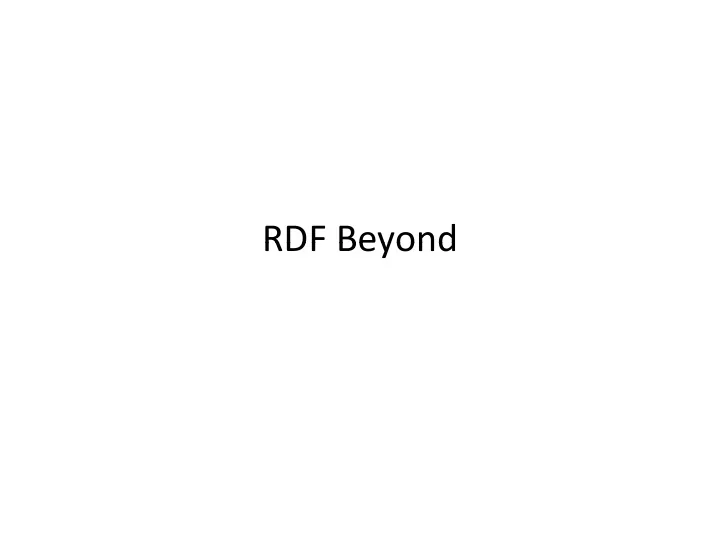

RDF Beyond RDF Beyond
Outline Outline • RDFa RDFa • Microformat • Schema.org S h
RDFa RDFa
RDFa RDFa • RDFa: A collection of attributes and processing p g rules for extending XHTML to support RDF. • HTML contains structured data, but not accessible to tools and applications accessible to tools and applications • RDFa is a specification for attributes to express structured data structured data • RDFa allows terms from multiple independently ‐ developed vocabularies to be freely intermixed • RDFa brings some part of XHTML machine processable
RDFa examples RDFa examples <html xmlns="http://www.w3.org/1999/xhtml" xmlns:foaf="http://xmlns com/foaf/0 1/" xmlns:foaf="http://xmlns.com/foaf/0.1/" xmlns:dc="http://purl.org/dc/elements/1.1/" > <head> <title>My home-page</title> <meta property="dc:creator" content="Mark Birbeck" /> <meta property dc:creator content Mark Birbeck /> <link rel="foaf:topic" href="http://www.formsPlayer.com/#us" /> </head> <body>...</body> </html>
RDFa examples RDFa examples <html xmlns="http://www.w3.org/1999/xhtml" xmlns:cal="http://www w3 org/2002/12/cal/ical#" xmlns:cal="http://www.w3.org/2002/12/cal/ical#" xmlns:xsd="http://www.w3.org/2001/XMLSchema" > <head><title>Jo's Friends and Family Blog</title></head> <body> <p> <p> I'm holding <span property="cal:summary"> one last summer Barbecue </span>, on on <span property="cal:dtstart" content="2007-09-16T16:00:00-05:00" datatype="xsd:dateTime"> September 16th at 4pm </span>. </p> p </body> </html> Adding datatype Adding datatype
RDFa examples RDFa examples <html xmlns="http://www.w3.org/1999/xhtml" xmlns:cal="http://www w3 org/2002/12/cal/ical#" xmlns:cal="http://www.w3.org/2002/12/cal/ical#" xmlns:xsd="http://www.w3.org/2001/XMLSchema" > <head><title>Jo's Friends and Family Blog</title></head> <body> <p typeof="cal:Vevent"> <p typeof cal:Vevent > I'm holding <span property="cal:summary"> one last summer Barbecue </span>, on on <span property="cal:dtstart" content="2007-09-16T16:00:00-05:00" datatype="xsd:dateTime"> September 16th at 4pm </span>. </p> p </body> </html> Adding typeof Adding typeof
RDFa examples RDFa examples <html xmlns="http://www.w3.org/1999/xhtml" xmlns:biblio="http://example org/" xmlns:biblio="http://example.org/" xmlns:dc="http://purl.org/dc/elements/1.1/" > <head> <title>Books by Marco Pierre White</title> </head> </head> <body> I think White's book '<span about="urn:ISBN:0091808189" typeof="biblio:book" property="dc:title"> Canteen Cuisine Canteen Cuisine </span>' is well worth getting since although it's quite advanced stuff, he makes it pretty easy to follow. You might also like <span about="urn:ISBN:1596913614" typeof="biblio:book" property="dc:description"> p p y p White's autobiography </span>. </body> </html>
RDFa RDFa • RDFa allows authors to mark up human ‐ RDFa allows authors to mark up human readable data with machine ‐ readable information for browsers and other information for browsers and other applications to interpret by using a few simple XHTML attributes XHTML attributes
Use case Use case • Alice: a blogger who publishes a mix of professional Alice: a blogger who publishes a mix of professional and personal articles a http://example.com/alice All content on this site is licensed under <a href="http://creativecommons.org/licenses/by/3.0/"> a Creative Commons License </a>. All content on this site is licensed under <a rel=“kicense” href="http://creativecommons.org/licenses/by/3.0/"> a Creative Commons License </a>.
Use Case Use Case <div xmlns:dc="http://purl org/dc/elements/1 1/"> <div xmlns:dc="http://purl.org/dc/elements/1.1/"> <h2 property="dc:title">The trouble with Bob</h2> <h3 property="dc:creator">Alice</h3> ... </div>
Use Case Use Case <div xmlns:dc="http://purl.org/dc/elements/1.1/"> <div about="/alice/posts/trouble_with_bob"> <h2 property="dc:title">The trouble with Bob</h2> <h3 property="dc:creator">Alice</h3> ... </div> <div about="/alice/posts/jos_barbecue"> <h2 property="dc:title">Jo's Barbecue</h2> <h3 property="dc:creator">Eve</h3> ... </div> ... </div>
Use Case Use Case <div typeof="foaf:Person" xmlns:foaf="http://xmlns.com/foaf/0.1/"> <p property="foaf:name"> Alice Birpemswick </p> <p> Email: <a rel="foaf:mbox" href="mailto:alice@example.com">alice@example.com</a> </p> <p> Phone: <a rel="foaf:phone" href="tel:+1-617-555-7332">+1 617.555.7332</a> </p> </di > </div>
Use Case <div xmlns:foaf="http://xmlns.com/foaf/0.1/" about="#me" rel="foaf:knows" > <ul> <li typeof="foaf:Person"> <a property="foaf:name" rel="foaf:homepage" href="http://example.com/bob/">Bob</a> </li> <li typeof="foaf:Person"> i <a property="foaf:name" rel="foaf:homepage" href="http://example.com/eve/">Eve</a> </li> <li typeof="foaf:Person"> <a property="foaf:name" rel="foaf:homepage" href="http://example.com/manu/">Manu</a> </li> </li> </ul> </div>
MICROFORMAT MICROFORMAT
Microformats Microformats • A way of thinking about data A way of thinking about data • Design principles for formats • Adapted to current behaviors and usage • Adapted to current behaviors and usage patterns • Highly correlated with semantic XHTML • Highly correlated with semantic XHTML • A set of simple open data format standards that are actively developing and implementing that are actively developing and implementing for more/better structured blogging and web microcontent publishing in general microcontent publishing in general
Microformats are NOT Microformats are NOT • A new language g g • Infinitely extensible and open ‐ ended • An attempt to get everyone to change their behavior and rewrite their tools • A whole new approach that throws away what already works today already works today • A panacea for all taxonomies, ontologies, and other such abstractions • Defining the whole world, or even boiling the ocean
Microformat principles Microformat principles • Solve a specific problem Solve a specific problem • Start as simple as possible • Design for humans first, machines second i f h fi hi d • Reuse building blocks from widely adopted standards • Modularity/embeddability y/ y • Enable and encourage decentralized development content services development, content, services
Microformat Microformat • They use ‘span’ element because this is a They use span element because this is a basic, versatile, element that works almost everywhere on the web <p class="vcard">Hi, my name is <span class="fn">Jamie Jones</span> and I dig microformats!</p> • Provide their own vocabularies Provide their own vocabularies – hCard (your information) – XFN (your networks about friends and contacts) (y ) – hCalendar (events) – hReview (review movies, books, and more) ( )
Examples Examples <div id="hcard-Ying-Ding" class="vcard"> <a class="url fn" href="http://info.slis.indiana.edu/~dingying/">Ying Ding</a> //i i i i / i i / i i / <div class="org">Indiana University</div> <a class="email" href="mailto:dingying@indiana.edu">dingying@indiana.edu</a> <div class="adr"> <div class="street-address">1320 E 10th</div> <span class="locality">Bloomington</span> < l "l lit ">Bl i t </ > , <span class="region">Indiana</span> , <span class="postal-code">47405</span> <span class="country-name">USA</span> </div> <div class="tel">8128555388</div> <p style="font-size:smaller;">This <a <p style font size:smaller; >This <a href="http://microformats.org/wiki/hcard">hCard</a> created with the <a href="http://microformats.org/code/hcard/creator">hCard creator</a>.</p> </div> Generate your own one: http://microformats.org/code/hcard/creator, for more tools: http://microformats.org/code ‐ tools
SCHEMA.ORG SCHEMA.ORG
Recommend
More recommend